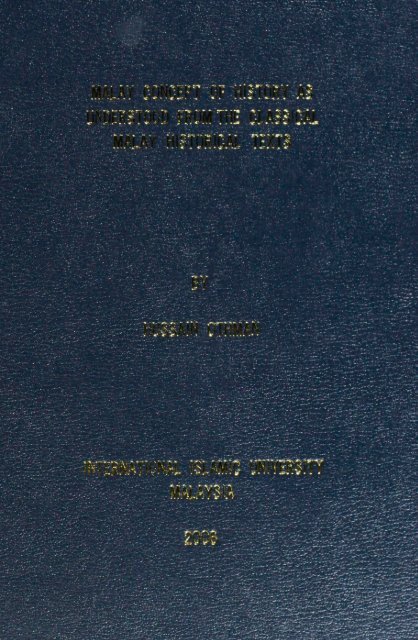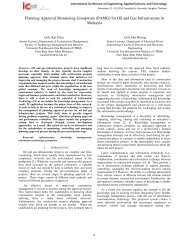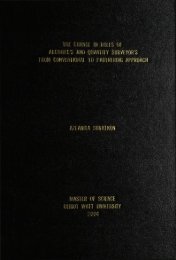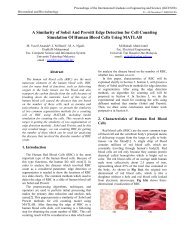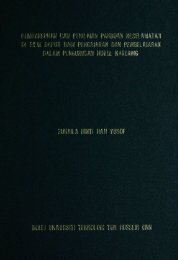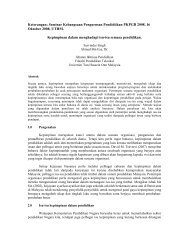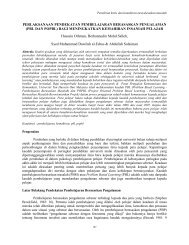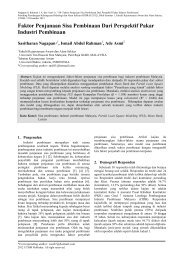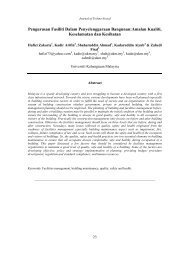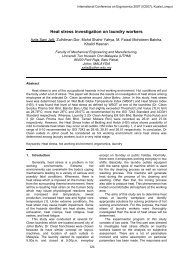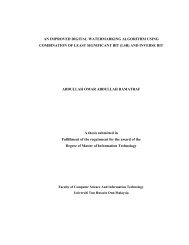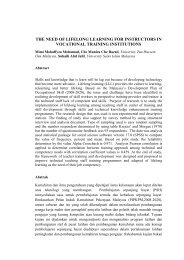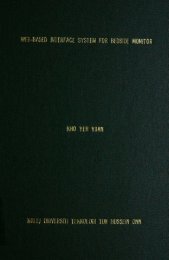PDF - UTHM Institutional Repository
PDF - UTHM Institutional Repository
PDF - UTHM Institutional Repository
Create successful ePaper yourself
Turn your PDF publications into a flip-book with our unique Google optimized e-Paper software.
PERPUSTAKAAN <strong>UTHM</strong><br />
"30000001866746*
MALAY CONCEPT OF HISTORY AS<br />
UNDERSTOOD FROM THE CLASSICAL<br />
MALAY HISTORICAL TEXTS<br />
BY<br />
HUSSAIN OTHMAN<br />
INTERNATIONAL ISLAMIC UNIVERSITY<br />
MALAYSIA<br />
2006
MALAY CONCEPT OF HISTORY AS<br />
UNDERSTOOD FROM THE CLASSICAL<br />
MALAY HISTORICAL TEXTS<br />
BY<br />
HUSSAIN OTHMAN<br />
A dissertation submitted in partial fulfilment<br />
of the requirement for the degree of<br />
Doctor of Philosophy in Islamic Civilization<br />
International Institute of Islamic Thought and<br />
Civilization (ISTAC)<br />
International Islamic University<br />
Malaysia<br />
SEPTEMBER 2006
ABSTRACT<br />
Studies conducted by western scholars on the history of the Malays since the<br />
beginning of the European colonisation had resulted in a number of undesirable<br />
outcomes. The works resulted from these studies were detrimental to the worldviews<br />
of the Malays and it was through these works that the misconceptions on Malay<br />
history mainly originated. The misconceptions rooted from two major factors. Firstly,<br />
the western bias views towards Malay history due to their pride over the superiority of<br />
their political power within the Malay region. Secondly, the rampant negative<br />
perceptions over the classical Malay historical texts. In order to counter their<br />
arguments and to reestablish a proper Malay concept of history, this study suggested a<br />
reinvestigation on the Malay classical texts using a proper and appropriate method.<br />
This study aims at a redevelopment of the Malay concept of history as understood by<br />
the Malays from their classical historical texts. For the purpose of the study, three<br />
great books (Karya Agung) of Malay history, namely Hikayat Raja-raja Pasai,<br />
Sejarah Melayu or Malay Annals and Hikayat Merong Mahawangsa were hereby<br />
selected to be the major sources from which the Malay concept of history could be<br />
unveiled and redeveloped.<br />
Generally, this study employed a traditional historical and cosmological analysis<br />
method which is neither quantification nor psychohistory. Specifically, philological<br />
and the traditional cosmological methods were two major approaches utilized in order<br />
to unveil the concept of Malay history from the selected texts. In philological method,<br />
the main concern is to study the external contents of the classical Malay historical<br />
texts. While in the traditional cosmological approach, the internal aspects of the texts<br />
were analyzed by utilizing the traditional cosmological approach as practiced by the<br />
scholars in this field. Modern historical approach had indeed unable to explain most of<br />
these internal aspects of the contents particularly regarding the mythological and<br />
legendary aspects.<br />
Through these approaches, a remarkable finding showed that the Malays owned a very<br />
special concept of history. Even the most unhistorical aspects of the classical Malay<br />
historical texts were finally discovered to be embodied a number of significant<br />
historical values. Some suggestions and recommendations had been made for further<br />
studies in the future.<br />
ii
qc. LOJV ^k O^JJ^L? UJ3>U5JUUI1I I^J ^UJIJII (jc. dij^Jl Qji<br />
(worldview) u^ 1 ijji '^utSj jjSMj • ajuLJI<br />
AjAjJI 6_>lajll [J- 0 J (JL)^ fjfr^ 4 Jj-la ctjlmti liA (j-a tiDUajl .(jjJj^Loll<br />
(jjSj^.viaV .t-JaljaJ)?! ji liA J] ,jli3l QluQujUl t^aiill oi>, J^C.<br />
(JLojjII (—IjiaJl i^k AJALLUJI (jlc. ji^jjLaxiuilJ (JikV JJ^-AM ^UjUll c_JIc. ^Ujljll ^Lolxllj<br />
^jstjij Ii* I jJ^Lall (>a_y-ra3ll (jJc. ^kjSaj ^ibpjia ;Lulj .LuaVI<br />
Jlgiklj .'v> i AjSaui^SJl AjjjXJI (j^aji/iill j^Jc- ili^Jl ^^-jSj q^iy^Jl<br />
L^jja-qL^j I gvSwTt yjutijpl < _ \ i nl i A\ jLyuall (J«»"nii ttilLl J} i—iLiiajj<br />
j^ilb UjS> (jytiJl is^ ^-a^ill SjSs]I 2 -.j^ • -H ^Liil ill Iii (jlajiJl (jj<br />
jl.^/JI LjjSjl AJjJ^Ull Ajijtfll jtLLl ttSl5j O<br />
m<br />
.^oUl ^ cIa^JI ja,J3J! (jia_>*j tt^Uj
ABSTRAK<br />
Kajian-kajian yang dijalankan terhadap sejarah orang Melayu oleh saijana-sarjana<br />
barat sejak awal zaman penjajahan tidak selalunya menghasilkan dapatan yang kita<br />
inginkan. Hasil-hasil keija para saijana barat ini sebenarnya didapati mengancam<br />
pandangan alam (worldview) orang-orang Melayu dan dari sinilah beberapa salah<br />
faham tentang sejarah Melayu berputik. Tinjauan awal kajian ini telah mendedahkan<br />
bahawa salah faham terhadap sejarah Melayu ini timbul akibat daripada dua faktor.<br />
Pertamanya ialah sikap berat sebelah orang-orang barat terhadap sejarah Melayu<br />
akibat daripada keangkuhan mereka di atas kekuatan politik yang mereka pegang<br />
sekian lama di rantau ini. Keduanya ialah persepsi negatif mereka yang melulu<br />
terhadap teks-teks kesusasteraan Melayu termasuklah teks-teks sejarah klasik. Untuk<br />
mematahkan hujah mereka dan mengembalikan semula konsep sejarah Melayu yang<br />
sebenarnya maka adalah dicadangkan agar teks-teks Melayu klasik dikaji semula<br />
secara bersungguh-sungguh dengan menggunakan kayu ukur yang sepatutnya.<br />
Kajian ini bertujuan untuk membina semula konsep sejarah orang Melayu sepertimana<br />
yang difahami oleh orang-orang Melayu daripada teks-teks sejarah klasik mereka.<br />
Untuk tujuan ini tiga buah buku Karya Agung sejarah Melayu iaitu Hikayat Raja-raja<br />
Pasai, Sejarah Melayu ataupun Malay Annals dan Hikayat Merong Mahawangsa<br />
telah dipilih sebagai sumber utama.<br />
Secara umumnya kajian ini menggunakan kaedah tradisional analisis sejarah dan<br />
kosmologi yang mana ianya tidak melibatkan kajian berbentuk kuantifikasi mahupun<br />
psiko-sejarah. Untuk menjelaskan konsep sebenar sejarah bagi orang Melayu daripada<br />
teks-teks terpilih dua kaedah utama digunakan iaitu kaedah filologi dan pendekatan<br />
tradisional pengkajian kosmologi. Dalam kaedah filologi, tumpuan utama kajian ini<br />
ialah mengkaji aspek luaran isi kandungan teks-teks sejarah Melayu klasik. Manakala<br />
kaedah pendekatan tradisional pengkajian kosmologi digunakan untuk mengkaji<br />
aspek-aspek makna dalaman teks. Pendekatan moden dalam kajian sejarah sebenarnya<br />
tidak mampu untuk menjelaskan kebanyakan daripada isi kandungan dalaman teks<br />
khususnya yang berkaitan dengan unsur-unsur legenda dan dongengan.<br />
Penemuan kajian ini sungguh memberangsangkan dan telah menunjukkan bahawa<br />
orang-orang Melayu sebenarnya mempunyai konsep sejarah yang tersendiri dan<br />
sangat istimewa. Beberapa aspek yang sebelum ini dikatakan tidak bernilai sejarah<br />
sebenarnya didapati mempunyai nilai sejarah yang besar. Beberapa cadangan telah<br />
dikemukakan agar kajian lanjutan diteruskan.<br />
iv
APPROVAL<br />
The dissertation of Hussain Othman has been approved by the following;<br />
Baharudin Ahmad<br />
Supervisor<br />
Osman Bakar<br />
Internal Examiner<br />
Hashim Haji Musa<br />
External Examiner<br />
Ibrahim M. Zein<br />
Chairman<br />
v
DECLARATION<br />
I hereby declare that this dissertation is the result of my own investigations, except<br />
what otherwise stated. I also declare that it has not been previously or concurrently<br />
submitted as a whole for any other degrees at HUM or other institutions.<br />
Hussain Othman<br />
Signature: Da,e:l:.?!L<br />
vi
INTERNATIONAL ISLAMIC UNIVERSITY MALAYSIA<br />
DECLARATION OF COPYRIGHT AND<br />
AFFIRMATION OF FAIR USE OF UNPUBLISHED<br />
RESEARCH<br />
Copyright © 2006 by Hussain Othman. All rights reserved.<br />
MALAY CONCEPT OF HISTORY<br />
AS UNDERSTOOD FROM THE CLASSICAL MALAY HISTORICAL<br />
TEXTS<br />
No part of this unpublished research may be reproduced, stored in a retrieval<br />
system, or transmitted, in any form or by any means, electronic, mechanical,<br />
photocopying, recording or otherwise without the prior written permission of the<br />
copyright holder except as provided below.<br />
1. Any material contained in or derived from this unpublished research may<br />
only be used by others in their writing with due acknowledgement<br />
2. IIUM or its library will have the right to make and transmit copies (print or<br />
electronic) for institutional and academic purposes<br />
3. The IIUM library will have the right to make, store in a retrieval system and<br />
supply copies of this unpublished research if requested by other universities<br />
and research libraries.<br />
Affirmed by Hussain Othman<br />
Signature Date<br />
vii
ACKNOWLEDGEMENTS<br />
In the Name of Allah, Most Gracious, Most Merciful. I thank Him for His mercy and<br />
blessing enabling me to complete this dissertation. Peace and blessing to the Prophet<br />
Muhammad s.a.w, the educator of mankind. First and foremost, my deepest<br />
appreciation goes to my respected supervisor, Associate Prof. Dr. Baharudin Ahmad<br />
for his expert guidance, critical ideas, continuous advice and useful suggestions for the<br />
completion of this dissertation. His ability to "see things beyond the things" had<br />
inspired my •writing right from the very beginning to the end.<br />
I owe a special thanks to the professors, lecturers and staffs at International Institute of<br />
Islamic Thought and Civilization (ISTAC), HUM for their assistance throughout my<br />
studies at ISTAC. I would also like to extend my gratitude to Prof. Emeritus Datuk Dr.<br />
Osman Bakar and Prof. Dr. Hashim Haji Musa for their professional advice on my<br />
research. My appreciation also goes to my grandfather Prof. Ali Taib whose life<br />
experience has set the standard at which I have to exceed.<br />
I wish to express my sincere gratitude to my institution Kolej Universiti Teknologi<br />
Tun Hussein Onn (KUiTTHO), the Rector and Deputy Rectors of KUiTTHO and<br />
Department of Civil Servants Malaysia (JPA) for sponsoring my study. My<br />
aeiniowledgements would also be incomplete without extending my appreciation to all<br />
my colleagues, especially Dr. Berhanuddin for his motivating ideas, Ustaz Abdullah<br />
Sulaiman for his supportive guidance, Mrs. Salawati and Miss Mimi Nahariah for<br />
their patience of proofreading my dissertation and Ustaz Hisyam for his useful advice<br />
regarding the Arabic texts. Not to forget to all my colleagues in Pusat Pengajian<br />
Kemanusiaan dan Komunikasi and KUiTTHO.<br />
I am also deeply indebted to my family, especially to my mother Hajjah Che Amah<br />
Haji Ishak who has never given up praying for my success from the very beginning of<br />
my life. An equal appreciation is also extended to my beloved wife Mrs. Noor Azwa<br />
Muiiaini for her moral support and patience and to my son Muhammad Hafiz Amzar<br />
who has missed much of my attention. Finally, I wish to express my appreciation to<br />
my brothers Mohd. Suhaimi and Ahmad Zaki, my sisters Zaleha and Sakinah for their<br />
moral supports.<br />
viii
CONTENTS<br />
Abstract ii<br />
Abstract in Arabic iii<br />
Abstract in Bahasa Malaysia iv<br />
Approval Page v<br />
Declaration Page vi<br />
Copyright Page vii<br />
Acknowledgements viii<br />
List of Tables and Diagrams xii<br />
List of Abbreviations xiii<br />
Arabic Transliteration Table xiv<br />
CHAPTER ONE: INTRODUCTION 1<br />
Background of the Study 2<br />
Problem Statements 3<br />
Objectives of the Study 7<br />
The Importance and Significance of the Study 8<br />
Texts Selection 12<br />
Literature Review 15<br />
Reason for Selecting the Topic 24<br />
Relevance of the Present Inquiry 25<br />
Methods of the Study 27<br />
The Scope and the Limitation of the Study 30<br />
CHAPTER TWO: SOME MISCONCEPTIONS 32<br />
The Old View: The History of Colonial Powers 33<br />
The Portuguese and the History of Malay Archipelago 33<br />
The Dutch and the History of Malay Archipelago 41<br />
The British and the History of Malay Archipelago 47<br />
The Emergence of New View: the Study of Local Malay History 51<br />
The Misconceptions in the Study of Classical Malay Historical Texts 61<br />
What Are the Misconceptions Resulted from the Studies? 62<br />
How Did the Misconceptions Emerged? 68<br />
The Need for a Proper Malay Concept of History 73<br />
CHAPTER THREE: HISTORICAL THOUGHT OF THE MALAYS 76<br />
The Foundation of the Malay Historical Thought 77<br />
Malay Historical Thought in Pre-historic Times 78<br />
Hinduism and Buddhism in Early Malay Historical Thought 87<br />
The Islamization and Its Impact on the Malay Historical Thought 96<br />
CHAPTER FOUR: THREE SELECTED TEXTS 110<br />
Three Classical Texts of Malay History Ill<br />
Hikayat Raja Pasai 113<br />
Background of the Text 113<br />
Manuscripts and Published Editions 115<br />
IX
Studies and Comments 118<br />
The Essential of the Contents 121<br />
Sejarah Melayu or Malay Annals 122<br />
Background of the Text 122<br />
Manuscripts and Published Editions 129<br />
Studies and Comments 132<br />
The Essential of the Contents 138<br />
Hikayat Merong Mahawangsa 139<br />
Background of the Text 139<br />
Manuscripts and Published Editions 141<br />
Studies and Comments 143<br />
The Essential of the Contents 148<br />
CHAPTER FIVE: THE CHARACTERISTICS OF THE MALAY<br />
HISTORIOGRAPHY AS DEPICTED BY THE SELECTED TEXTS 149<br />
General Characteristics of Malay Historiography 149<br />
The Characteristics of Malay Historiography in the Selected Texts 153<br />
The Characteristics of Hikayat Raja Pasai 155<br />
Myths and Legends 156<br />
The Origin and the Genealogies of the Pasai Kings 157<br />
Didactic Values of Hikayat Raja Pasai 158<br />
No Date and No Chronological Order of Writings 159<br />
The Literary Styles 160<br />
The Islamization of the King and the Kingdom 161<br />
The Elements of the Wills or Wasiat 163<br />
The Establishment of the Kingdom 165<br />
The Period of the Writing or Copying Process 165<br />
The Characteristics of the Sejarah Melayu 167<br />
Myths and Legends 169<br />
The Origin and the Genealogy of the Kings 171<br />
The Didactic Values and the Elements of Wa'ad 173<br />
No Accurate Dates and No Chronological Order 175<br />
Written in a Literary Styles 176<br />
The Islamization of the King and the Kingdom 178<br />
The Period of the Writing or Copying Process 179<br />
The Characteristics of Hikayat Merong Mahawcmgsa 180<br />
Myths and Legends 181<br />
The origin and the Genealogies of the King 182<br />
The Didactic Values 183<br />
No Accurate Dates and Chronological Orders 185<br />
Literary Styles 186<br />
The Islamization of the King and the Kingdom 187<br />
The Element of Wills or Wasiat 188<br />
The Story of the Establishment of the Kingdom 190<br />
The Period of the Writing or Copying Process 191<br />
CHAPTER SIX: MALAY CONCEPT OF HISTORY 194<br />
Malay Concept of History in the Selected Texts 195<br />
A Broader Concept of Malay Histoiy 196<br />
x
Conceptual Understanding of Myths and Legends 199<br />
The Concept of Man in Malay History 222<br />
The Concept of Universe or 'alam (cosmos) in Malay History 247<br />
The Concept of Time, Space and Motion 259<br />
Other Significant Concepts of Malay History 278<br />
CHAPTER SEVEN: CONCLUSION 281<br />
BIBLIOGRAPHY 289<br />
APPENDIX 1 304<br />
APPENDIX 2 307<br />
APPENDIX 3 314<br />
APPENDIX 4 316<br />
APPENDIX 5 317<br />
APPENDIX 6 318<br />
APPENDIX 7 319<br />
APPENDIX 8 - 320<br />
xi
LIST OF TABLES AND DIAGRAMS<br />
Table / Diagram No. Page<br />
Table 1 The characteristics of Malay historiography<br />
according to Mohd. Taib Osman 151<br />
Table 2 The characteristics of Malay historiography<br />
according to Siti Hawa Salleh 151<br />
Table 3 The characteristics of Malay historiography<br />
according to Zahrah Ibrahim 152<br />
Table 4 Summary of the characteristics of Malay historiography 153<br />
Table 5 The characteristics of Sejarah Melayu<br />
according to De Jong 168<br />
Diagram 1 The concept of man as servant of God 316<br />
Diagram 2 The concept of universe; our present world 317<br />
Diagram 3 The concept of universe; al-dunya and al-akhirah 318<br />
Diagram 4 The concept of universe; al-akhirah 318<br />
Diagram 5 The concept of universe; eschatology 319<br />
Diagram 6 The concept of universe in relation to man-God 320<br />
xii
LIST OF ABBREVIATIONS<br />
ABIM Angkatan Belia Islam Malaysia (Malaysian Muslim Youth Movement)<br />
DBP Dewan Bahasa dan Pustaka<br />
HMM Hikayat Merong Mahawangsa<br />
HRP Hikayat Raja-raja Pasai<br />
ISTAC International Institute of Islamic Thought and Civilization<br />
JIAEA Journal of Indian Archipelago and East Asia<br />
JMBRAS Journal of Malayan Branch Royal Asiatic Society<br />
JRAS GBI Journal of Royal Asiatic Society Great Britain and Ireland<br />
JRASSB Journal of Royal Asiatic Society Singapore Branch<br />
JSAH Journal of Southeast Asian History<br />
MBRAS Malaysian Branch of Royal Asiatic Society<br />
MS Manuscript<br />
MSS Manuscripts<br />
SM Sejarah Melayu or Malay Annals<br />
xiii
f-<br />
ARABIC TRANLITERATION TABLE<br />
><br />
CHAPTER ONE<br />
INTRODUCTION<br />
Most of the modern approaches in the study of history founded by western historians<br />
had been in the practice since the collapse of western medieval thoughts. 1 These<br />
approaches were also applied on the study of Malay history. Thus, looking at the<br />
Malay history in the modern sense, there were a number of western worldviews<br />
outspread from the writings of the local and colonial scholars. With regard to their<br />
superiority in the economic, social, political and particularly the intellectual spheres<br />
during the period of colonisation, colonial scholars had easily dominated the study of<br />
Malay history. Almost every single text of the classical Malay history was studied and<br />
commented by these colonial scholars. Their commentaries became the most<br />
authoritative references to the later scholars including the locals. This fact led to the<br />
decline of the historical understanding among the Malays and had also caused a<br />
number of confusions on their historical worldviews. Colonialism and its intellectual<br />
understanding had indeed harmed the perspectives of Malay history, one of the most<br />
crucial parts of the Malay intellectual domain. This study therefore, is intended to<br />
reveal some important facts related to the issues of the colonisation and the study of<br />
Malay history. First, the fact that Malay history at large was inflicted by the rampant<br />
utilization of the modern western methods in historical study. Second, during then-<br />
course of studies, most of the western colonial scholars as well as their local<br />
1 One important aspect of the break between medieval and Renaissance is the role of scientific<br />
revolution beginning with Copernicus (1473-1543), for it was the scientific world view and its<br />
attendant technological progress which most decisively separated us from the Middle Ages. This so<br />
called "scientific world view" was also responsible for the rise of modern perspective on history, the<br />
perspective that casting away the traditional understanding of history. Classical Malay histoiy was<br />
unfortunately one of the traditional understandings about history. See further William R. Cook and<br />
Ronald B. Herzman, The Medieval World View: An Introduction, (New York: Oxford University Press,<br />
1983), 317-319.
adherents, had mistreated and consequently misunderstood the classical Malay<br />
literature texts in general and the classical Malay historical texts in particular. Third,<br />
the classical Malay historical texts were in fact the products of the Malay excellent<br />
intellectual epochs. Last but not least, in connection to this third point, it was believed<br />
that all these classical Malay historical texts contained a firm and proper concept of<br />
Malay history. It was this concept that this study is intended to reveal and explore<br />
further.<br />
BACKGROUND OF THE STUDY<br />
Discussion in chapter two focuses on some of the misconceptions on Malay history<br />
resulted from the studies and writings of western colonial scholars. It was proved that<br />
even in their early days of colonisation, western colonial scholars were actively<br />
involved in the study of the history of this region. However, the focus of their study<br />
was rather confined to their own colonial events and activities, and at the same time<br />
neglecting local sources and the presence of the Malays in history. The views related<br />
to this type of study should be called "old view" or appropriately referred as<br />
"europocentric or eurocentric view", the historical view concerned only to the<br />
presence of the colonial powers such as Portuguese, Dutch and British in the Malay<br />
region. The records, reports and books produced by western scholars during this<br />
period were rather prejudiced towards the Malays and their historical sources. In the<br />
next stage of their colonial intellectual interest, these colonial scholars began to sense<br />
the importance and the precious values of the classical Malay historical texts.<br />
Gradually, the interest to study these texts increased among the Portuguese scholars<br />
primarily through their contacts with the Malay royal families. This was the beginning<br />
of a "new view", the historical view which focused on the study of local history. The<br />
2
interest subsequently increased faster when the Dutch scholars took control over the<br />
colonial intellectual hegemony in this region. The Malay literary manuscripts and<br />
historical records preserved by the Dutch during this period were indeed so immense<br />
in comparison with the Portuguese and the British. British scholars in another instance<br />
were equally excellent in expanding their intellectual domination and as a result<br />
numerous works on the local Malay history written in English language were<br />
published. In total, the contribution of the colonial scholars on the study of local<br />
Malay history became so enormous and inconceivable even by the Malays. The value<br />
of their contribution, though meaningful in terms of the number were unfortunately<br />
meaningless in terms of preserving and promoting a proper concept of Malay history.<br />
Review on the writings of Richard Winstedt in the middle of the second chapter<br />
proved this contention clearly. The misconceptions on Malay history resulted from the<br />
studies conducted by colonial scholars such as Winstedt were then found to be so<br />
rampant. Realizing these circumstances, the Malays were indeed left in a critical<br />
position either to keep quiet and be a passive disciple to the colonial scholars or<br />
choose to re-evaluate and to insert new understanding to these classical Malay<br />
historical texts. It seems that the latter option is more appropriate to be selected by the<br />
Malay scholars and researchers or otherwise no other educated persons could be relied<br />
upon in order to revive these invaluable legacies of the Malays. Therefore, a proper<br />
study on the classical Malay historical texts is so crucial at this moment especially for<br />
the purpose of unveiling a proper Malay concept of history.<br />
PROBLEM STATEMENTS<br />
Many colonial scholars were not being fair in judging and evaluating the local Malay<br />
sources through local perspective throughout their course of studies on the classical<br />
3
texts of Malay history. Instead, they used their own narrow methodologies and biased<br />
interpretations. Methodologically, colonial scholars believed that they had based their<br />
studies on a firm intellectual ground and had utilized the methods and guidelines<br />
which most of them perceived as the most advance and effective compared to others.<br />
During their course of studies on Malay history they had implemented the methods<br />
properly and followed the guidelines accurately and therefore the results of these<br />
studies according to them were always as expected. Thus, looking from their own<br />
perspective, there was no such misconception whatsoever resulted from these studies<br />
as contrary believed. However, if thorough observation being conducted on their<br />
modern historical method and how it was implemented during their course of study,<br />
the methodological defects would certainly be detectable. The classical Malay<br />
historical texts are the product of the Malay classical genius and not the product of<br />
modern historical writings. For that reason, it was apparently incompatible to use the<br />
modern yardstick in order to measure and judge these classical genius works. Take for<br />
example, what will we consider if we see someone attempted to measure the tallest<br />
building in the world by using a six-inch ruler? We would certainly consider the<br />
method to be defective. Similarly, we should also consider that the western modern<br />
methods on the study of history to be defective in evaluating the classical Malay<br />
historical texts.<br />
In terms of the interpretation, it was believed that these colonial scholars and<br />
their local adherents were prejudice and bias towards classical Malay historical texts.<br />
Only a small number of them looked at the content of the classical Malay history from<br />
a more comprehensive perspective. The majority on the other hand, preferred to deal<br />
with those contents separately and as a result their views on Malay history were<br />
confined within the narrowed perspective as they had subscribed. They will pick the<br />
4
small historical facts of the contents and conducted an extensive study on it without<br />
considering other facts related to the general contents. Thus, finally they had to<br />
struggle in dealing with those particulars and the result is the widespread of narrow<br />
perspectives on Malay history within their writings and commentaries. Many of them<br />
found themselves difficult to interpret and explain the Malay historical perspectives<br />
and facts thoroughly since their earlier historical understanding was narrowly<br />
confined.<br />
The defective methods and narrow interpretations of these colonial scholars<br />
and their local adherents were basically resulted from two most important problems.<br />
First, their basic conception and understanding of history is modern and western in<br />
nature. Second, the approaches and methods implemented by them are rather narrow.<br />
Let us see how the first problem had caused the western methods to be defective. The<br />
concept of history according to their own perspective had been adopted in<br />
understanding the classical Malay texts of history. Collingwood's concept and<br />
definition for example, 2 had been generally accepted and adopted by most of the<br />
western historians. As a result, their bias views continued to confine them from<br />
focussing more attention on a deeper and broader understanding regarding the local<br />
sources of Malay history. Based on the view such as Collingwood's, many of these<br />
colonial scholars and local adherents had rejected the solid historical values of the<br />
indigenous works of Malay history such as Sejarah Melayu, Hikayat Raja Pasai and<br />
more especially Hikayat Merong Mahawangsa. On the second problem, it was<br />
discovered that the colonial scholars and their local adherents are practicing a purely<br />
western methods and approach in studying classical Malay historical texts. In early<br />
2 History was defined as an objective science, contains humanistic values, a rational discourse and a<br />
science inspired by the writer himself. See further R.G. Collingwood, The Idea of History, (Oxford:<br />
Oxford University Press, 1956), 10-11.
stages they had brought the romanticism, pure philological and narrow comparative<br />
studies approach into the study of classical Malay historical texts. As a result, many<br />
classical historical texts were classified as only "romance history". In addition,<br />
comparative study method, which was among the most popular approaches during this<br />
period, had blamed many texts as carbon copies of the legacies of Indian, Persian and<br />
Arabic literature. 3 In later a stage, they brought in the positivism approach, which was<br />
made possible for them to use a broader implementation of scientific knowledge in the<br />
study of literature. Based on this approach, only the objective aspects of the texts will<br />
be given the consideration. Subjective aspects such as the themes, the historical and<br />
intellectual impact of the texts and further intrinsic meaning of the texts were<br />
generally neglected. Finally, it was discovered that more classical Malay historical<br />
texts were considered as non-historical works. 4<br />
In summary, there were numerous extensive efforts in studying the classical<br />
Malay historical texts conducted by the western as well as local scholars. In spite of a<br />
number of advantages that could be gained from their works and commentaries, there<br />
were also numerous major misconceptions threatening the local Malay historical<br />
concept and perspectives. These misconceptions, if not properly corrected, will<br />
eventually destroy and demolish the conceptual aspects of the classical Malay history.<br />
Therefore this fact explained clearly the problem statement of this study.<br />
This study intends to offer an appropriate approach to the classical Malay<br />
historical texts. However, during this course of study several problems and difficulties<br />
are also expected. First and foremost is the rare sources related to the topic of Malay<br />
concept of history. In this respect local sources are especially rare and difficult to<br />
3 Siti Hawa Haji Salleh, "Teks Melayu Tradisional: Interpretasi dan Penilaian dalam Pengkajian<br />
Kesusasteraan Melayu," in Teks Cerminan Nilai Budaya Bangsa, edited by Othman Puteh (Kuala<br />
Lumpur: Dewan Bahasa dan Pustaka, 1994), 200-201.<br />
4 Ibid., 203-204.<br />
6
access. In order to solve this problem several works of traditional local and foreign<br />
scholars such as Hamzah Fansuri, Nuruddin Al-Raniri, Frithjof Schuon, Seyyed<br />
Hossein Nasr, Mircea Eliade, Ananda Coomaraswamy, Joseph Champbell and many<br />
more are consulted. Although the perspectives of foreign scholars are not purely based<br />
on their understanding upon Malay historical and literary texts, their works take into<br />
consideration most of the basic understanding of traditional Malay history in which<br />
religion and history co-exist. Last but not least is the problem of the fusion of Islamic<br />
and non-Islamic ideas in the selected texts. The existence of this problem has brought<br />
the study to utilize both Islamic and non-Islamic sources during the course of<br />
discussion in chapter six.<br />
OBJECTIVES OF THE STUDY<br />
Based on the above discussion and upon reaching its conclusion there are several<br />
important objectives of the study that essentially need to be achieved. The study is<br />
intended,<br />
i. To discuss the development of the study on Malay history since the early<br />
period of its establishment.<br />
ii. To unveil some of the misconceptions arose among the westerners and<br />
their local adherents during their course of studies on the classical Malay<br />
historical texts.<br />
iii. To discover possible reasons of the misconceptions in the study of Malay<br />
history and how they were then spread.<br />
iv. To rediscover the intellectual history of the Malays and how the Malays<br />
came to make contact with the great ideas from the great civilizations<br />
especially the Indian and Islamic civilizations.<br />
7


